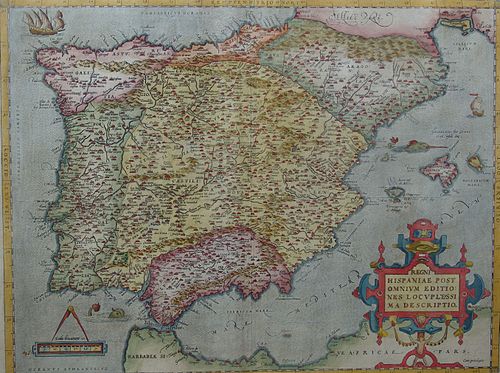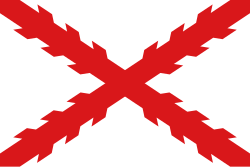Habsburg Spain
Habsburg Spain means the history of Spain over the 16th and 17th centuries (1506–1700). This was when Spain was ruled by the major branch of the Habsburg dynasty. Under Habsburg rule (mostly under Charles I and Philip II), Spain reached the height of its influence and power. The Hapsburgs had land including the Americas; the East Indies in Asia; the Low Countries, territories now in France and Germany in Europe. From 1580 to 1640 they had the Portuguese Empire; and various other lands such as small enclaves like Ceuta and Oran in North Africa. Habsburg Spain was, for well over a century, the world's greatest power. For this reason, this period of Spanish history has also been called the "Age of Expansion."
Monarchia Hispaniae[b] | |||||||||||||||||||||||
|---|---|---|---|---|---|---|---|---|---|---|---|---|---|---|---|---|---|---|---|---|---|---|---|
| 1516–1700 | |||||||||||||||||||||||
 1570 map of the Iberian Peninsula | |||||||||||||||||||||||
| Capital | Madrid (1561–1601; 1606–1700) Valladolid (1601–06) | ||||||||||||||||||||||
| Religion | Roman Catholic Church | ||||||||||||||||||||||
| Demonym(s) | Spanish, Portuguese | ||||||||||||||||||||||
| Government | Composite monarchy | ||||||||||||||||||||||
| House of Habsburg | |||||||||||||||||||||||
• 1516–1556 (first) | Charles I | ||||||||||||||||||||||
• 1665–1700 (last) | Charles II | ||||||||||||||||||||||
| Legislature | Cortes of Castile Courts of Aragon Catalan Courts Corts Valencianes Cortes of Navarre Cortes of Portugal | ||||||||||||||||||||||
| Historical era | Early Modern period | ||||||||||||||||||||||
• Accession of Philip I of Castile | 26 November 1504 | ||||||||||||||||||||||
• | 23 January 1516 | ||||||||||||||||||||||
| 1568–1648 | |||||||||||||||||||||||
| 1580–1640 | |||||||||||||||||||||||
| 1635–1659 | |||||||||||||||||||||||
| 1640–1668 | |||||||||||||||||||||||
• | 1 November 1700 | ||||||||||||||||||||||
| 1701–1714 | |||||||||||||||||||||||
| Currency | Spanish real | ||||||||||||||||||||||
| |||||||||||||||||||||||
| Today part of | Spain, Portugal | ||||||||||||||||||||||
With the Habsburgs, Spain was one of the greatest political and military powers in Europe and the world for much of the 16th and 17th centuries. During the Habsburg's period, Spain ushered in the Spanish Golden Age of arts and literature producing some of the world's most outstanding writers and painters and influential intellectuals, including Teresa of Ávila, Pedro Calderón de la Barca, Miguel de Cervantes, Francisco de Quevedo, Diego Velázquez, El Greco, Domingo de Soto, Francisco Suárez and Francisco de Vitoria.
Spain or "the Spains", referring to Spanish territories across different continents in this period, initially covered the entire Iberian peninsula, including the kingdoms of Aragon, Castile, León, Navarre and, from 1580, Portugal.
The marriage of Isabella I of Castile and Ferdinand II of Aragon in 1469 resulted in the union of the two main crowns, Castile and Aragon, which eventually led to the de facto unification of Spain, after the culmination of the Reconquista with the conquest of Granada in 1492 and of Navarre in 1512–1529. Isabella and Ferdinand were bestowed the title of "Catholic King and Queen" by Pope Alexander VI in 1494,[3] and the term Monarchia Catholica (Catholic Monarchy, Modern Spanish: Monarquía Católica) remained in use for the monarchy under the Spanish Habsburgs. The Habsburgers period is formative of the notion of "Spain" in the sense that was institutionalized in the 18th century.
Spain as a unified state came into being de jure after the Nueva Planta decrees of 1707 that succeeded the multiple crowns of its former realms. After the death in 1700 of Spain's last Habsburg king Charles II, the resulting War of the Spanish Succession led to the ascension of Philip V of the Bourbon dynasty and began a new centralizing state formation.
Among the most outstanding figures of this period were Diego Velázquez, El Greco, Miguel de Cervantes, Teresa of Ávila, Pedro Calderón de la Barca, Francisco de Vitoria, Domingo de Soto and Francisco Suárez.
Habsburg Spain Media
- Middle Arms of Charles I of Spain, Charles V as Holy Roman Emperor-Middle (1530-1556).svg
Arms of Charles I, representing his territories in Spain (top) and his other European possessions (bottom)
- Conquista-de-México-por-Cortés-Tenochtitlan-Painting.png
17th century painting depicting the 1521 Fall of Tenochtitlan. Spanish colonists were led to invade the Aztec Empire by conquistador Hernán Cortés.
- Habsburg Map 1547.jpg
A map of the dominion of the Habsburg monarchy following the Battle of Mühlberg (1547) as depicted in The Cambridge Modern History Atlas (1912); Habsburg lands are shaded green
Europa regina, associated with a Habsburg-dominated Europe under Charles V
The Battle of Lepanto (1571)
Spanish Road (1567–1620)
Siege of Haarlem (1572–73)
Spanish Fury at Antwerp, demonstration of Spanish military power as a leading world power at the time.
Notes
References
- ↑ Monarchia Hispanica.google.com, Monarchia Hispaniae. digital.ub.uni.
- ↑ Reyno de España, google.com
- ↑ Kamen, H. (2005). Spain 1469–1714: A Society of Conflict. Routledge:Oxford. p. 37.
